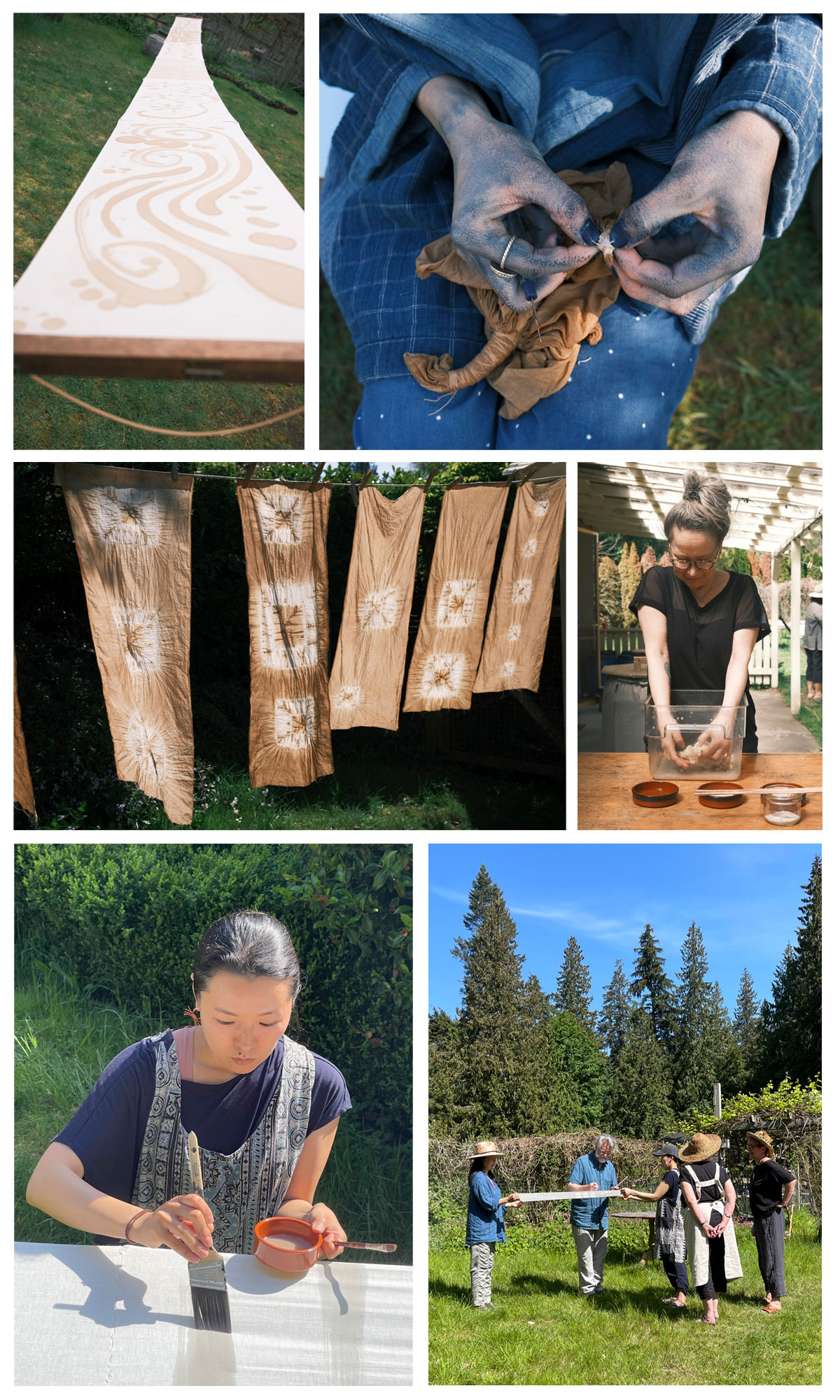Collaboration: The Way of Indigo Comes to Maiwa — Takayuki and Tomoe Ishii
THE WAY OF INDIGO COMES TO MAIWA
For the entire month of May 2023, visiting artisans Takayuki Ishii and his wife Tomoe Ishii instructed Maiwa staff in a remarkable set of Japanese textile techniques.
Takayuki Ishii has made a name for himself as a young artisan adapting traditional sukomo production (a time-consuming fermentation process used to prepare persicaria tinctoria for dyeing) to meet modern needs.
The first thing Takayuki did when he arrived in the last week of April was to build two, 200-litre fermentation vats.
Takayuki brought specially prepared hardwood ash from Japan and transformed it into ash water (a traditional source of alkali). The ash water was mixed with various ingredients including Takayuki's sukomo, sake, and wheat bran. Preparing the vats for a month of dyeing is a delicate process. Unlike many other vats, once these are built no additional indigo is added; the vats are maintained and used until they are exhausted. To make fermentation vats on this scale in a new location takes considerable skill and experience.
With the indigo vats established, Takayuki and Tomoe began teaching the techniques that would be used to prepare different pieces of cloth for dyeing. Shibori stitching included boushi and katano shibori. Resist techniques were taught using both katazome and tsutsugaki.
Stencils were designed by participants, reviewed and then cut with expert guidance. Takayuki is a master of katazome paste production, he adjusts the recipe to give the perfect consistency and viscosity.

Instruction took place in two Maiwa locations: our studio in East Vancouver, and the Maiwa Natural Dye Garden, located on the Sunshine Coast of British Columbia. Each week a new group of participants stitched a patterned resist; and designed and cut their stencils before heading to the Sunshine Coast to work with the dye vats.
Among the precious cargo brought by Takayuki and Tomoe Ishii was a sealed jar of three-year old fermented persimmon juice - used in the kakishibu process. After applying stitched resist, pieces were immersion dyed in kakishibu. The persimmon juice was also painted directly onto stretched cotton.
Pieces which had been resist printed with the katazome paste were attached to shinshi sticks and gently lowered into the vat. Stitched resist pieces were dipped by hand - resulting in wonderfully blue fingernails.
There's a certain connection that happens when you share an indigo vat. Hands under the surface, holding fabric, making certain that every fold is opened to receive the blue. There's a lot of laughter as stories are passed back and forth. The dips are timed, and everyone carefully removes their piece. Tiny drips. No bubbles.

With the boushi shibori pieces dyed, dried, and unwrapped, it was time for Tomoe to teach the ink-painting component of tsujigahana. Pine-soot ink is carefully prepared by grinding very fine pine soot together with deer horn glue and a little water. Tomoe's brushwork is exquisite.
Finally Tomoe demonstrated Japanese sewing, known as wasai, to complete the pieces. Everything made by all the groups was gathered together for a final showing at the Maiwa studio.
Longtime Maiwa staff (and katazomi artist) Yukiko Blackwell provided translation between Japanese and English. With so many techniques and over a month of lessons, Yukiko was able to ensure that the subtle nuances of technique passed smoothly between cultures. Yukiko stands between Takayuki and Tomoe.

ABOUT PASSAGES IN CRAFT
Since founding Maiwa in 1986, Charllotte Kwon has been looking for ways to bring artisans and inspiration together. Her vision for a month-long event, where each and every employee of Maiwa could renew their relationship with traditional craft, began at the end of the COVID pandemic. With in-person workshops successfully transitioned to online, Charllotte began to re-imagine a new form of collaboration between Maiwa and the larger world of artisans and traditional textile techniques. In this recent event hosted by Maiwa, staff participated on company time, meals were catered, and Charllotte herself did the cooking when the group visited the indigo vats on the Sunshine Coast. Charllotte was assisted by family and the larger extended family that is Maiwa.
This is our first event in Passages in Craft. It has been more than successful, it has renewed our hope, our energy and it has let us know that so much is possible.


























0 comments
We moderate comments to keep posts on-topic, avoid spam, and inappropriate language. Comments should appear within 24 hours.